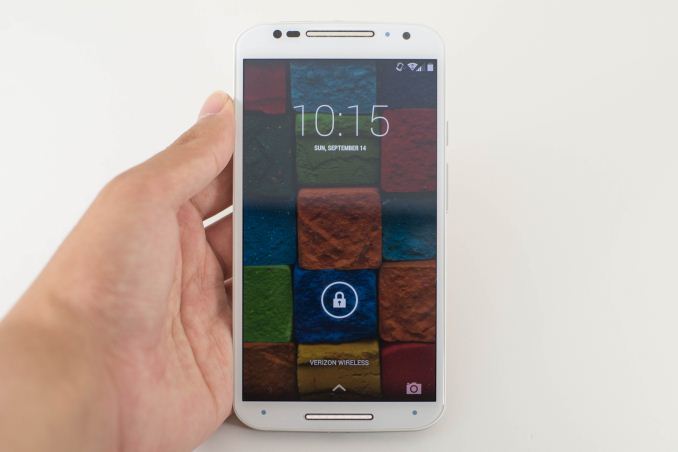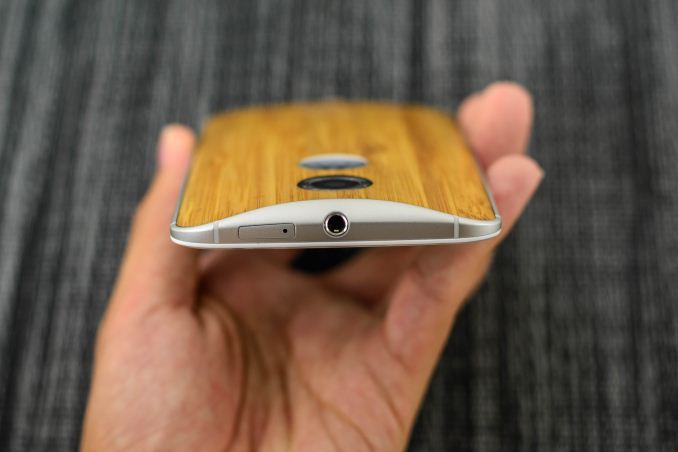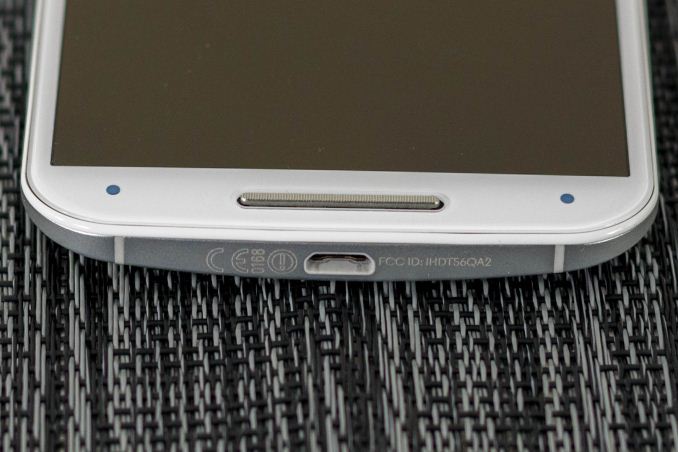The New Motorola Moto X (2nd Gen) Review
by Joshua Ho on September 17, 2014 9:00 AM EST- Posted in
- Smartphones
- Motorola
- Android
- Mobile

Introduction
While I talked about Motorola’s issues in the launch article for the new Moto X, it’s well worth repeating. Motorola has been through a lot these past few years. Once the iconic symbol of Android with their Droid smartphones, Motorola had lost its way. It wasn’t unusual to see one phone launch after the other, with no real regard for strategy, and no real cohesive message to tie all of their devices together. If anything, there was a point where Motorola had become an ODM for network operators in the US, with no real international presence. After Google acquired it in 2012, we saw the launch of the Moto X in 2013. The amount of hype that I saw online before the announcement of the Moto X was unlike anything I’ve ever seen.
Unfortunately, the device that launched didn’t quite fit with the hype. The Snapdragon S4 Pro chipset was decidedly mid-range by the time it launched. The display was good for the time, but AMOLED wasn’t quite the imminent LCD replacement that it is today. The camera was also rather unfortunate at launch. For better or worse, the Moto X was a phone with the right size and shape, but a lot of hardware choices that aged poorly. This leads us to the new Moto X. On the surface, this phone corrects a lot of issues that were present in the original Moto X. The new Moto X brings an SoC that is up to par with its competition, a new camera with a Sony sensor, and an improved AMOLED panel. Of course, I’m not going to spend too much time covering the basic specifications when a table will suffice.
| Motorola Moto X (Gen 1) | Motorola Moto X (Gen 2) | |
| SoC | 1.7 GHz Dual Core Snapdragon S4 Pro | 2.5 GHz Quad Core Snapdragon 801 |
| RAM/NAND | 2 GB, 16/32/64GB NAND | 2GB, 16/32GB NAND |
| Display | 4.7” 720p Super AMOLED | 5.2” 1080p Super AMOLED |
| Network | 2G / 3G / 4G LTE (Qualcomm MDM9x15 IP block UE Category 3 LTE) | 2G / 3G / 4G LTE (Qualcomm MDM9x25 IP block UE Category 4 LTE) |
| Dimensions | 129 x 65.3 x 5.7-10.4mm, 139 grams | 140.8 x 72.4 x 3.8-9.9 mm, 144 grams |
| Camera | 10MP Rear Facing, 1/2.6" CMOS size (OV10820), 2.1MP FFC | 13MP Rear Facing, 1/3.06" CMOS size (Sony IMX135), 2.1MP FFC |
| Battery | 2200 mAh, 3.8V, 8.36 Whr | 2300 mAh, 3.8V, 8.74 Whr |
| OS | Android 4.4.4 | Android 4.4.4 |
| Connectivity | 802.11a/b/g/n/ac + BT 4.0, USB2.0, GPS/GNSS, MHL, DLNA, NFC | 802.11a/b/g/n/ac + BT 4.1, USB2.0, GPS/GNSS, MHL, DLNA, NFC |
| SIM Size | NanoSIM | NanoSIM |
As with most reviews, physical impressions are always a good place to start. In terms of look and feel, the new Moto X starts off incredibly well. The metal frame is something that Motorola is especially proud of, as they've managed to enable an external antenna design without causing some of the infamous deathgrip issues. At any rate, it really feels great in the hand, especially because of the varying thickness. The metal frame can be as thin as 3.3mm in the corners, which really feels razor thin. Fortunately, the center is much thicker to provide for better grip. As a result, the phone is secure in the hand and I never really felt like I would drop it. Overall, I really think the feel of the phone is great. While the size is approaching an uncomfortable level, it manages to stay just short of it because the phone is so thin.
However, I’d like to cut this short as I’ve already given most of my initial impressions in the launch piece. While I haven’t been able to get around to writing my experience with Motorola’s tour, Motorola and their PR team have done an incredible job of introducing the product and allowing for plenty of time to get first impressions, photos, and ask all kinds of questions.
Cellular Architecture
Instead, given the amount of information disclosed by Motorola, I wanted to start this review with a discussion about cellular architecture, as it’s one of the few areas where we still seem to be working with black boxes. For those that are unfamiliar with the basics of how current RF architecture is set up, there are a few major components to talk about. We have antennas, antenna switches and duplexers, band filters, power amplifiers, a transceiver (which is made of multiple parts but that’s for another day), and the modem.
So let’s talk about what’s in the new Moto X. While antennas are still an area I’ve been working on learning more about, we can talk about band support on the Moto X. I’ve attached a table below with a full list of supported bands.
| Motorola Moto X (2014) | ||||||||
| FCC ID | Operator/Region Target | CDMA Bands | GSM | WCDMA | LTE | CA | ||
| IHDT56QA1 (XT1095/XT1097) | AT&T/T-Mobile USA | - | 850, 900, 1800, 1900 | 850, 900, AWS, 1900, 2100 | 2, 3, 4, 5, 7, 17, 29 | - | ||
| IHDT56QA2 (XT1096) | Verizon | 800, 1900 | 850, 900, 1800, 1900 | 850, 900, 1900, 2100 | 2, 3, 4, 7, 13 | - | ||
| IHDT56QA3 (XT1092) | ? | 800, 1900 | 850, 900, 1800, 1900 | 850, 900, AWS, 1900, 2100 | 2, 4, 5, 12, 17, 25, 26, 41 | - | ||
| IHDT56QA4 (XT1093/XT1094) | EU | - | 850, 800, 1800, 1900 | 850, 900, 1800, 1900, 2100 | 1, 3, 7, 8, 20 | - | ||
What might be notable is the lack of carrier aggregation on the new Moto X, which suggests that there is only a WTR1625L transceiver inside, with no WFR1620 companion chip to go with it. This is a rather conventional configuration at this point, and I suspect that phones with support for carrier aggregation will have to wait until WTR3925 which should be in most high end phones in 2015. The modem is also common at this point, as the MDM9x25 IP block in Snapdragon 800/801 has been around since the LG G2 which launched a year ago.
Of course, the real story here is the antenna tuner which I also wrote about in the launch piece. While most of the antenna tuner is hidden from view, there is one aspect that seems to be exposed to the OS. This one aspect is Cypress Semiconductor’s CapSense controller. This sounds strange, but I don’t think there’s any other explanation for why this controller is present. While it’s normally used for capacitive buttons such as in the Samsung Galaxy S/Galaxy Note line, there are no capacitive buttons or sliders present on the phone. In addition, none of the gestures/actions seem to rely upon capacitive sensing. This seems to rely upon the IR sensor system instead, so that doesn’t make sense either. The touchscreen is definitely an Atmel solution. This leaves the antenna tuner. While a bit outlandish, it seems that this controller is capable of detecting capacitance directly in addition to determining whether a finger/hand is on the sensor or not. While I’m sure that it’s necessary for Motorola to measure the standing wave ratio/signal reflection in addition to capacitive sensing on the relevant antenna pieces, this could give Motorola’s antenna tuner an advantage in speed as the capacitive sensors could detect the change in capacitance and pre-emptively change the tuning in the antennas instead of waiting for an increase in signal reflection before attempting to retune the antenna.













179 Comments
View All Comments
Dirty_Punk - Wednesday, September 17, 2014 - link
one thing that I can't understand, is why on Anandtech Iphone has such good battery life when ALL PEOPLE OF THE WORLD can demonstrate that iPhone battery life sucks... in all tests iPhone 5/5s are very near to LG G2 (at worst a 30% lower), that in real life have at least the double of the battery of iPhones....oscarnyc - Wednesday, September 17, 2014 - link
while I wouldn't go so far as to say that iPhone battery life 'sucks' I share your surprise at how well it does in AT's laboratory testing vs. real life experience, where, in my experience, it is little better than the current gen Moto X.aman.agx - Thursday, September 18, 2014 - link
It looks like the benchmarks are targetting select functions while shutting down all other background processes. So they are not reflective of your real life experience. So for example the contextual services on moto x might be eating up much less battery overall than something similar on an iphone. But if you shut down both of those, i phone battery will seem like a giant.melgross - Thursday, September 18, 2014 - link
That's not true. It doesn't suck. It's not as good as the best devices out there, but it's better than most. I tend to get a full day out of my 5, and I usually use it fairly often.There's a lot of anti Apple prejudice on this site from posters. It's really sad.
spikebike - Wednesday, September 17, 2014 - link
So motorola decided to give consumes the worst of both worlds. Thicker to allow for changing the backplate, but somehow not allowing changing the battery. To make matters worse they epoxied in a poor battery. So the result is a $500 disposable phone, with poor battery life, and you get to throw it away when the $15 battery dies.soccerballtux - Thursday, September 18, 2014 - link
honestly I feel like this review was pretty harsh. The camera isn't horrible, the AMOLED screen enables extensive black background screen on, the battery life is good enough, the phone has great software...so why so much hate?lostleaf - Wednesday, September 17, 2014 - link
Josh, can you comment on whether the display is viewable with polarized sunglasses in both portrait and landscape? Also does this phone have aptx?soccerballtux - Thursday, September 18, 2014 - link
good call, I've noticed this on my phones lately. What's up with that?Impulses - Monday, September 22, 2014 - link
It's basically a result of how polarization works, grab a cheap camera lens polarizer and play with it a little. I think phones usually prioritize portrait use, which generally makes sense, but sucks for looking at navigation (in landscape) with polarized sunglasses.Alex J. - Wednesday, September 17, 2014 - link
Thank you for yet another detailed review and for saving me money and time. As a previous owner of first-gen Moto X it's pretty disappointing to see that new Moto X is barely better in some aspects, and in some it is actually a regression. Most importantly, it still has horrible battery life and mediocre camera. As much as I love "Active Display" I'm afraid I will have to look at other flagships, with better battery life and better cameras.